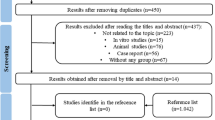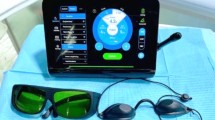Abstract
This study was conducted in order to compare clinical and histopathological outcomes for excisional biopsies when using pulsed CO2 laser versus Er:YAG laser. Patients (n = 32) with a fibrous hyperplasia in the buccal mucosa were randomly allocated to the CO2 (140 Hz, 400 μs, 33 mJ) or the Er:YAG laser (35 Hz, 297 μs, 200 mJ) group. The duration of excision, intraoperative bleeding and methods to stop the bleeding, postoperative pain (VAS; ranging 0–100), the use of analgesics, and the width of the thermal damage zone (μm) were recorded and compared between the two groups. The median duration of the intervention was 209 s, and there was no significant difference between the two methods. Intraoperative bleeding occurred in 100% of the excisions with Er:YAG and 56% with CO2 laser (p = 0.007). The median thermal damage zone was 74.9 μm for CO2 and 34.0 μm for Er:YAG laser (p < 0.0001). The median VAS score on the evening after surgery was 5 for the CO2 laser and 3 for the Er:YAG group. To excise oral soft tissue lesions, CO2 and Er:YAG lasers are both valuable tools with a short time of intervention and postoperative low pain. More bleeding occurs with the Er:YAG than CO2 laser, but the lower thermal effect of Er:YAG laser seems advantageous for histopathological evaluation.




Similar content being viewed by others
References
Fisher SE, Frame JW, Browne RM, Tranter RM (1983) A comparative histological study of wound healing following CO2 laser and conventional surgical excision of canine buccal mucosa. Arch Oral Biol 28:287–291
Fisher SE, Frame JW (1984) The effects of the carbon dioxide surgical laser on oral tissues. Br J Oral Maxillofac Surg 22:414–425
Frame JW, Das Gupta AR, Dalton GA, Rhys Evans PH (1984) Use of the carbon dioxide laser in the management of premalignant lesions of the oral mucosa. J Laryngol Otol 98:1251–1260
Frame JW (1985) Removal of oral soft tissue pathology with the CO2 laser. J Oral Maxillofac Surg 43:850–855
Bornstein MM, Suter VG, Stauffer E, Buser D (2003) The CO2 laser in stomatology. Part 2 (in German, in French). Schweiz Monatsschr Zahnmed 113:766–785
Ishii J, Fujita K, Komori T (2003) Laser surgery as a treatment for oral leukoplakia. Oral Oncol 39:759–769
Jerjes W, Upile T, Hamdoon Z, Al-Khawalde M, Morcos M, Mosse CA, Hopper C (2012) CO2 laser of oral dysplasia: clinicopathological features of recurrence and malignant transformation. Lasers Med Sci 27:169–179
Suter VG, Altermatt HJ, Dietrich T, Warnakulasuriya S, Bornstein MM (2014) Pulsed versus continuous wave CO2 laser excisions of 100 oral fibrous hyperplasias: a randomized controlled clinical and histopathological study. Lasers Surg Med 46:396–404
Ishii J, Fujita K, Komori T (2002) Clinical assessment of laser monotherapy for squamous cell carcinoma of the mobile tongue. J Clin Laser Med Surg 20:57–61
Goodson ML, Thomson PJ (2011) Management of oral carcinoma: benefits of early precancerous intervention. Br J Oral Maxillofac Surg 49:88–91
Jerjes W, Upile T, Hamdoon Z, Mosse CA, Akram S, Hopper (2011) Prospective evaluation of outcome after transoral CO(2) laser resection of T1/T2 oral squamous cell carcinoma. Oral Surg Oral Med Oral Pathol Oral Radiol Endod 112:180–187
Suter VG, Altermatt HJ, Dietrich T, Reichart PA, Bornstein MM (2012) Does a pulsed mode offer advantages over a continuous wave mode for excisional biopsies performed using a carbon dioxide laser? J Oral Maxillofac Surg 70:1781–1788
Jacobsen T, Norlund A, Englund GS, Tranæus S (2011) Application of laser technology for removal of caries: a systematic review of controlled clinical trials. Acta Odontol Scand 69:65–74
Schwarz F, Aoki A, Becker J, Sculean A (2008) Laser application in non-surgical periodontal therapy: a systematic review. J Clin Periodontol 35(8 Suppl):29–44
DiVito E, Peters OA, Olivi G (2012) Effectiveness of the erbium:YAG laser and new design radial and stripped tips in removing the smear layer after root canal instrumentation. Lasers Med Sci 27:273–280
Giannelli M, Formigli L, Bani D (2014) Comparative evaluation of photoablative efficacy of erbium:yttrium-aluminium-garnet and diode laser for the treatment of gingival hyperpigmentation. A randomized split-mouth clinical trial. J Periodontol 85:554–561
Broccoletti R, Cafaro A, Gambino A, Romagnoli E, Arduino PG (2015) Er:YAG laser versus cold knife excision in the treatment of nondysplastic oral lesions: a randomized comparative study for the postoperative period. Photomed Laser Surg 33:604–609
van As G (2004) Erbium lasers in dentistry. Dent Clin N Am 48:1017–1059
Zaffe D, Vitale MC, Martignone A, Scarpelli F, Botticelli AR (2004) Morphological, histochemical, and immunocytochemical study of CO2 and Er:YAG laser effect on oral soft tissues. Photomed Laser Surg 22:185–189
Romeo U, Libotte F, Palaia G, Del Vecchio A, Tenore G, Visca P, Nammour S, Polimeni A (2012) Histological in vitro evaluation of the effects of Er:YAG laser on oral soft tissues. Lasers Med Sci 27:749–753
Merigo E, Clini F, Fornaini C, Oppici A, Paties C, Zangrandi A, Fontana M, Rocca JP, Meleti M, Manfredi M, Cella L, Vescovi P (2013) Laser-assisted surgery with different wavelengths: a preliminary ex vivo study on thermal increase and histological evaluation. Lasers Med Sci 28:497–504
Abbas AE, Abd Ellatif ME, Noaman N, Negm A, El-Morsy G, Amin M, Moatamed A (2012) Patient-perspective quality of life after laparoscopic and open hernia repair: a controlled randomized trial. Surg Endosc 26:2465–2470
López-Jornet P, Camacho-Alonso F (2013) Comparison of pain and swelling after removal of oral leukoplakia with CO2 laser and cold knife: a randomized clinical trial. Med Oral Patol Oral Cir Bucal 18:e38–e44
Pogrel MA, Yen CK, Hansen LS (1990) A comparison of carbon dioxide laser, liquid nitrogen cryosurgery, and scalpel wounds in healing. Oral Surg Oral Med Oral Pathol 69:269–273
Wilder-Smith P, Arrastia AM, Liaw LH, Berns M (1995) Incision properties and thermal effects of three CO2 lasers in soft tissue. Oral Surg Oral Med Oral Pathol Oral Radiol Endod 79:685–691
World Medical Association Declaration of Helsinki (2013) Ethical principles for medical research involving human subjects. JAMA 310:2191–2194
Pick RM, Pecaro BC (1987) Use of the CO2 laser in soft tissue dental surgery. Lasers Surg Med 7:207–213
Bornstein MM, Winzap-Kälin C, Cochran DL, Buser D (2005) The CO2 laser for excisional biopsies of oral lesions: a case series study. Int J Periodontics Restorative Dent 25:221–229
Tuncer I, Ozçakir-Tomruk C, Sencift K, Cöloğlu S (2010) Comparison of conventional surgery and CO2 laser on intraoral soft tissue pathologies and evaluation of the collateral thermal damage. Photomed Laser Surg 28:75–79
Pié-Sánchez J, España-Tost AJ, Arnabat-Domínguez J, Gay-Escoda C (2012) Comparative study of upper lip frenectomy with the CO2 laser versus the Er, Cr:YSGG laser. Med Oral Patol Oral Cir Bucal 17:e228–e332
Tambuwala A, Sangle A, Khan A, Sayed A (2014) Excision of oral leukoplakia by CO2 lasers versus traditional scalpel: a comparative study. J Maxillofac Oral Surg 13:320–327
Kishore A, Kathariya R, Deshmukh V, Vaze S, Khalia N, Dandgaval R (2014) Effectiveness of Er:YAG and CO2 lasers in the management of gingival melanin hyperpigmentation. Oral Health Dent Manag 13:486–491
Hegde R, Padhye A, Sumanth S, Jain AS, Thukral N (2013) Comparison of surgical strip**; erbium-doped:yttrium, aluminum, and garnet laser; and carbon dioxide laser techniques for gingival depigmentation: a clinical and histologic study. J Periodontol 84:738–748
Acknowledgements
The authors thank Mr. Gabriel Fischer, significantis GmbH, Herzwil b. Köniz, Switzerland, for his assistance regarding the statistical analysis.
Author information
Authors and Affiliations
Corresponding author
Ethics declarations
The study protocol had been approved by the standing ethics committee of the State of Bern, Switzerland (Ref Nr. KEK-BE: 203/12).
Conflict of interest
The authors declare that they have no conflict of interest.
Funding
This study was supported by a grant from the Swiss Dental Association (grant number 271-13).
Informed consent
All patients included signed an informed consent to participate in the study. Examination and data collection were done according to the guidelines of the World Medical Association Declaration of Helsinki (version 2013).
Rights and permissions
About this article
Cite this article
Suter, V.G.A., Altermatt, H.J. & Bornstein, M.M. A randomized controlled clinical and histopathological trial comparing excisional biopsies of oral fibrous hyperplasias using CO2 and Er:YAG laser. Lasers Med Sci 32, 573–581 (2017). https://doi.org/10.1007/s10103-017-2151-8
Received:
Accepted:
Published:
Issue Date:
DOI: https://doi.org/10.1007/s10103-017-2151-8




